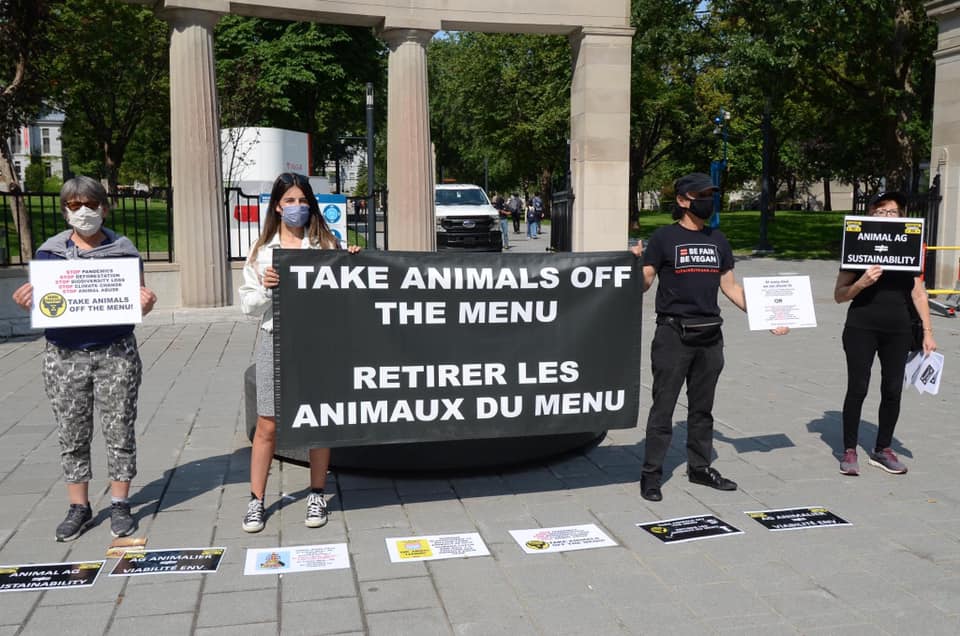
Our Request to Universities & Colleges:
TRANSITION TO 100% PLANT BASED MEALS
The grim prospect of a planet that will be virtually devoid of forests, wildlife and clean oceans is becoming a greater reality with each passing day. This is no longer futuristic but a stark fact given current trends.
The profound negative impact of animal agriculture on the environment, human health and animals is staggering. Currently 60% of the world’s biomass is livestock with humans at 36% and wildlife at a shocking 4%. Animal agriculture is the leading cause of GHG 51%, deforestation, water and air pollution and biodiversity loss. At the current rate of extinction virtually all wildlife will disappear by 2026.
The COVID-19 virus, the Marburg virus, the Ebola virus, the Nipah virus, the SARS virus, the MERS virus, the H7N9 bird flu, the H1N1 Swine flu and the seasonal flu can all be traced to have originated from other species. Please note all facts, trends and supporting references as well as associated documentaries are listed below.
Yet despite this well researched trend and outcome, very little has changed in the eating habits of the world population. Although advances have occurred in the development and consumption of plant based alternatives, the impact on the underlying negative trends has been negligible. There has simply not been sufficient mass adoption of plant based diets globally to reverse current negative trends.

Universities are at the forefront of science and education. Their mandate is to be objective visionaries at the front line of positive change and leadership. Universities should be emphasizing and enacting the policies required to move rapidly towards a 100% plant based diet at least within their institutions. As per the old adage “actions speak louder than words”.
However, the evidence is disappointing. Although many universities are now defining or accrediting themselves as following “sustainable practices” (ie practices which are ecologically sound, socially just and environmentally viable)”, beef, chicken, pork, fish, dairy, eggs etc. are still being served at virtually all university and college campuses. This is not ecologically sound nor environmentally viable. Although more plant based options are being made available, this is like putting out raging wildfires with garden hoses. It is simply and profoundly insufficient.
We are requesting that universities and colleges move forward quickly this academic year and transition all food services within their domain to 100% plant based offerings. This will be both inspirational and motivating for their students to follow plant based diets at home. And this will encourage students to spread the example within their families and friends.
This proposal is not radical nor bold – it is fundamentally essential if we are to reverse this destructive decline of the environment, its wildlife, human health (pandemics and diet related diseases), and to stop the incalculable confinement, torture and slaughter of billions of animals annually.
Documentaries supporting 100% plant based diets
1. The Game Changers (Netflix)
Presented by James Cameron, Arnold Schwarzenegger, Jackie Chan, Lewis Hamilton, Novak Djokovic and Chris Paul
2. Forks over Knives (Amazon, iTunes)
Forks Over Knives examines the profound claim that most, if not all, of the chronic diseases that afflict us can be controlled or even reversed by rejecting animal-based and processed foods.
3. Cowspiracy: The Sustainability Secret
Director: Kip Anderson, Keegan Kuhn
The film that environmental organizations don’t want you to see!
4. What the Health (online)
The Health Film that Organizations Don’t Want you to See!
5. Dominion the Movie (online)
Exposing the dark underbelly of modern animal agriculture through drones, hidden & handheld cameras, the feature-length film explores the morality and validity of our dominion over the animal kingdom.
References
- The COVID-19 virus, the Marburg virus, the Ebola virus, the Nipah virus, the SARS virus, the MERS virus, the H7N9 bird flu, the H1N1 Swine flu and the seasonal flu can all be traced to have originated from other species. When humans kill 1-3 trillion animals annually to dine on their bodies and secretions, viruses are bound to jump from the victim species to the consuming species.
https://theecologist.org/2020/jul/09/meat-and-pandemics-surprising-link
- Animal agriculture is the leading cause of GHG 51%, deforestation, water and air pollution and biodiversity loss and is linked to:
- 55% of erosion
- 60% of nitrogen pollution
- 70% of the dietary phosphorous footprint
https://sentientmedia.org/the-climate-crisis-secret/
- The biomass distribution on earth is now composed of 60% livestock, 36% humans and 4% wildlife
https://www.pnas.org/content/115/25/6506
- More than 80% of farmland is used for livestock but it produces just 18% of food calories and 37% of protein
- At current rates of decline, 100% of wild vertebrates will die off by 2026.
https://www.worldwildlife.org/pages/living-planet-report-2014
- At every meal, we drive 70 species extinct and kill 2 billion animals. With our current consumption pattern we are driving 200 species extinct each day which works out to 70 species per day. And we kill 0.97 – 2.7 Trillion sea animals and >74 Billion land animals (2016) per year for food alone.
https://www.pnas.org/content/114/30/E6089.full
http://www.fao.org/faostat/en/#home
https://www.climatehealers.org/
- Milk and other dairy products are the top source of saturated fat in the American diet, contributing to heart disease, type 2 diabetes, and Alzheimer’s disease. Studies have also linked dairy to an increased risk of breast, ovarian, and prostate cancers.
- World Scientists’ Warning to Humanity: A 2nd Notice 13 November 2017
“Especially troubling is the current trajectory of potentially catastrophic climate change due to rising GHGs from burning fossil fuels (Hansen et al. 2013), deforestation (Keenan et al. 2015), and agricultural production— particularly from farming ruminants for meat consumption (Ripple et al. 2014). Moreover, we have unleashed a mass extinction event, the sixth in roughly 540 million years, wherein many current life forms could be annihilated or at least committed to extinction by the end of this century.”
https://academic.oup.com/bioscience/article/67/12/1026/4605229
